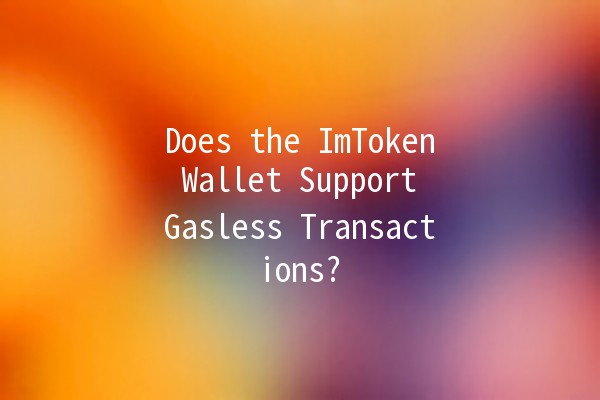The landscape of cryptocurrency wallets is evolving rapidly, with users increasingly seeking features that streamline their trading experiences. Gasless transactions, which allow users to make trades without paying gas fees upfront, are a hot topic. In this article, we will explore whether the ImToken wallet supports gasless transactions, delving into what this means for users and the potential benefits of such an arrangement.

Gas fees are payments made by users to validators on the Ethereum blockchain. They compensate for the computational energy required to process transactions and validate the network. Gasless transactions, on the other hand, allow users to execute trades or transactions without needing to handle gas fees directly. This can be particularly beneficial for users who may not have a sufficient amount of Ethereum (ETH) or other cryptocurrencies to cover these fees.
The ImToken wallet, known for its userfriendly interface and multichain support, plays a crucial role in facilitating crypto storage and management. To determine if the ImToken wallet supports gasless transactions, we will consider the following factors:
While the ImToken wallet has not explicitly stated its support for gasless transactions, the potential for such functionality exists, particularly through partnerships with dApps and the integration of meta transactions. Users should keep an eye on updates from the ImToken team regarding developments in this area, as it could lead to enhanced trading experiences and increased user engagement.
Gasless transaction technology refers to the ability to execute transactions on a blockchain without the need to hold the native cryptocurrency required for gas fees. It typically involves relayers who pay these fees on behalf of the user.
Example: If a user wishes to trade an ERC20 token on the Ethereum blockchain but does not have ETH for gas fees, a dApp using gasless technology can allow them to complete the transaction without upfront fees.
As of now, ImToken has not made any official announcements regarding the integration of gasless transactions. However, given the trend towards improving user experience and accessibility, there is potential for future support.
Gasless transactions maintain security through the same cryptographic principles as standard blockchain transactions. The user still signs the transaction, which ensures authenticity. However, users must trust the relayer appropriately.
To utilize gasless transactions, users typically must engage with dApps that support this feature. When using such platforms, check if they offer gasless options when trading or making transactions.
Several platforms such as DHF (Decentralized ance) projects and specific dApps may support gasless transactions. Always verify with the dApp if they currently support gasless transactions before engaging.
If a relayer fails to submit a transaction, it typically results in the transaction not being executed. However, the transaction signing process ensures that the user retains control, and they may resend the transaction through another means or relayer.
Exploring gasless transaction capabilities is important as cryptocurrency usage continues to grow. The future may see wider integration of such technologies into established wallets like ImToken, further simplifying user access to the blockchain.
(Note: This article focuses on the current state of gasless transactions related to ImToken. Always verify with the official sources for the most uptodate information on features and functionalities.)